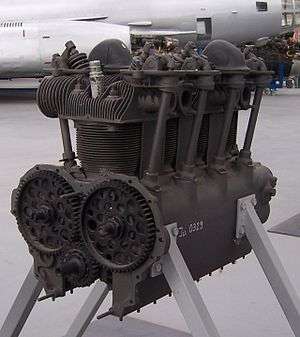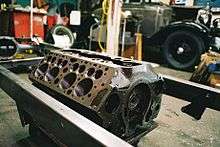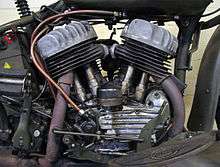Cam-in-block

The cam-in-block valvetrain layout of piston engines is one where the camshaft is placed within the cylinder block, usually beside and slightly above the crankshaft in a straight engine or directly above the crankshaft in the V of a V engine. This contrasts with an overhead camshaft (OHC) design which places the camshafts within the cylinder head and drives the valves directly or through short rocker arms.

Placing the camshaft inside the engine block has a long history in its use in valve-in-block engines, in straight and V configurations, the Ford flathead being exemplary of the type. Pushrod overhead valve engines with the cam in the block were long used in Chevrolet and Buick straight engines from the 1930s through the mid-1950s and in various similar six-cylinder engines until the extensive employment of the V6 configuration in the 1980s.
There are three main cam-in-block designs:
- L-head, also known as L-block, flathead or sidevalve
- F-head
- I-head, also known as overhead valve (OHV)
L-head

L-head (flathead) refers to the pushrod valvetrain configuration in which the valves are placed in the engine block beside the pistons. The design was common on early engine designs, but has since fallen from use.
Generally L-head engines use a small chamber on one side of the cylinder to carry the valves. This has a number of advantages, primarily in that it makes the cylinder head much simpler. It also means that the valve can be operated by pushing directly up on it, as opposed to needing some sort of mechanical arrangement to push the valves down. It may also lead to slightly easier cooling, as the valves and operating rods are out of the way of the cylinder, making a cooling jacket simpler to construct (but see below). The line of intakes along the side of the engine lead to the name L-head, due to the cylinders having the shape of an upside-down L. This configuration is also known as sidevalve, as the valves are located beside the cylinders.
On the downside, the L-head engine also requires the airflow to make at least a 90° turn to enter the cylinder, which makes it less efficient; colloquially it's said that such an engine has poorer "breathing". Breathing was not greatly emphasized in past production cars because engines could not run long and reliably at high speed due to other factors. This was a minor concern given the benefits in simplicity.
Although L-head inline 4 and 6-cylinder engines were frequently used for automobiles, tractors, etc., the best known L-head automotive engine is the early 20th century Ford V-8, which has both sets of valves (intake and exhaust) located on the inside of the "Vee," and which are all operated by a single camshaft located above the crankshaft. The exhaust follows a lengthy path to leave the engine. This virtually guarantees that the engine will need an unusually large coolant radiator to avoid overheating under sustained heavy use. A flathead design in a V engine, with the air intake/fuel system and all of the exhaust and intake valves inside of the "V" requires that the exhaust gas be passed between the cylinders to outside of the V to the exhaust system. Exhaust heat is thus passed to the coolant (as it exits the engine between the cylinders). In the Ford V-8 flathead design, manufactured from 1932 through 1952, the center exhaust port on the outside of the block exhausts the gasses from two cylinders, exacerbating the high heat problem. This "very hot in the middle" problem makes this particular engine prone to heat-related stress and cracks in the cylinder block. In line engine exhaust gas exits the block more directly and does not cross between the cylinders and is a more temperature-stable design. Whenever exhaust ports and valves are in the cylinder head, exhausting heat has far less time to heat the coolant, and such engines are more durable under high load conditions and a similar sized engine will require less coolant radiator capacity than a flathead V-8.

Due to the heating and efficiency problems, L-head engines fell from high power uses such as aircraft engines fairly quickly, prior to World War I. They lived on for some time in the automotive world and were used in the World War II Jeep, for instance. L-heads are no longer used in automobile engines, although they remain in common use for small-engine applications in lawnmowers and generators. Because of their heat-retaining design, the size of valves and the compression ratio are limited (the valve/combustion chamber is away from the piston top typically creating a larger combustion space--a lower compression ratio), which in turn reduces available power and economy. Not all L-heads are cam-in-block engines; the location of the camshaft varies in this layout.
T-head
.jpg)
In some flathead engines, the exhaust valves were in a second set of similar chambers on the other side of the cylinder and driven by a second camshaft. This crossflow layout is referred to as a T-head.
F-head
- Main article: F-Head Engine
The F-head layout (not to be confused with flathead) can be thought of as a combination of L-head and I-head: the intake manifold and its valves are located atop the cylinders (in the cylinder head, as in an I-head design) and are operated by pushrods, but the exhaust manifold and its valves are located beside the cylinders (in the block, as in an L-head design). The exhaust valves are either roughly or exactly parallel with the pistons; their faces point upwards and they are not operated by pushrods, but by direct contact with a lifter contacting the camshaft. Reverse variation of F-head with side intake and in head exhaust were also made- the Ford V8 overhead exhaust valve conversions to flathead engines were to decrease the overheating under load problems in commercial service. The Indian/Henderson 4-cylinder motorcycle engine family used both designs- the overhead exhaust was again an overheating consideration design.
This was a more expensive engine design. Its advantages over competing L-head engines included more power from its higher compression, better intake mixture flow, less susceptibility to pinging, and greater reliability from its cooling of the exhaust valve and its spring (and having half the number of pushrods of an OHV engine). With only one valve in the head, and one in the block, larger valves can be used than in an OHV engine, to offset the poorer airflow of a side exhaust valve.
For years the British motor car firms Rolls-Royce and Rover used this arrangement. From 1927 to 1929, the American firm Hudson used a 6-cylinder engine of this form as well, but this engine is not to be confused with that of the race-winning Hudsons of the 1950s. The last major use was the Willys Hurricane engine, used in civilian Jeeps in the 1950s and 1960s. It was replaced by the I-head design.
I-head
- Main article: Pushrod engine
The I-head design is one in which the entry and exit valves and ports are contained in the cylinder head. It was developed by the Scottish-American David Dunbar Buick. It employed pushrod-actuated valves parallel to the pistons and is still in use today in some designs (notably several engines produced by General Motors and Chrysler).
It has several advantages over L- and F-head designs, but the most notable is the fact that the intake charge and exhaust gases have a more direct path into and out of the combustion chambers, increasing power, improving fuel efficiency and reducing noxious exhaust emissions.
See also
External links
- Pushrod (OHV), SOHC and DOHC engine animated diagrams
- Concentric camshafts for cam-in-block VVT explained